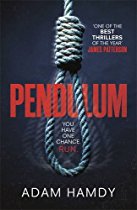When reviewing my latest novel, Pendulum, one critic singled out a line from the book as an example of writing that was not to his liking: ‘Primal pain stabbed searing barbs that jolted Wallace back to consciousness.’
I found it interesting that the critic in question selected that particular line because it was an instance where I’d specifically tried to convey a sense of the suffering endured by the protagonist and describe the pain he was feeling in terms that might give readers a better understanding of his experience.
Pain is terrible, it is sharp, stabbing, agonising, intense, harrowing, acute, burning and so much more, but it is also nothing in the sense that it has no real meaning beyond the subjective. I cannot feel your pain any more than you can feel mine, but that subjectivity is even more profound: neither of us can properly communicate our pain in a way that the other truly understands. Language simply isn’t up to the task; we can only try to choose the most appropriate words and hope that they convey the gist of the suffering.
‘Bond ground his teeth until he thought they would break. The sweat of pain began to form pools in the sockets of his closed eyes.’ Goldfinger, Ian Fleming
In his book The Language of Pain: Finding Words, Compassion, and Relief, physician David Biro examines the relationship between pain and language and finds an inadequate, imperfect connection. Think about how you last described pain to a doctor. Consider what they asked. Where does it hurt? Is it constant or intermittent? Is it throbbing or stabbing? How would you say the pain feels? These are the imprecise questions of someone trying to visualise something they can never properly comprehend.
In The Body in Pain: The Making and Unmaking of the World, Elaine Scarry goes beyond inadequacy and suggests that pain is a profoundly negative experience, that it is the essence of negation. According to Scarry, pain destroys language and makes it impossible for us to have common understanding. Scarry believes that creativity is humanity’s response to pain’s destructive negativity; the things we create are what bind us together and give us a shared experience of life.
The inadequacy of language to communicate pain is a real drag for writers, particularly crime writers who often trade in suffering. Our senses give the world objective context. Most of us have seen the colour blue, tasted something sweet, heard music, or felt something soft, and although our senses may be imperfect and might taint our perception, these external stimuli give us a shared understanding of the world which can be more or less accurately conveyed by language.
‘My lungs caught fire, and the need to breathe laced my vision with sparks and whorls of fire. I could feel the strength going out of me and my consciousness receding into blackness.’ The Eye of the Tiger, Wilbur Smith
Pain is an internal experience. It doesn’t exist in the world and cannot be perceived by anyone other than the sufferer, who cannot properly describe the experience in objective terms because he or she has never felt anyone else’s pain. There is no blue pain, sweet pain, musical pain, or soft pain. There is nothing external about pain and that makes it difficult to write about. Even if one can imagine the pain, or recall it from a past experience, finding language to convey the suffering to a reader is a challenge.
David Biro suggests metaphor, not only as a method of communicating pain, but as a way of understanding and treating it. Biro believes that picturing pain and giving it metaphorical identity helps with communication, comprehension, and eradication. Imagine how much time would be saved in diagnosis if there was a universal catalogue of pain. My calf feels like it’s being broiled by an angry cloud. Ah, that’s cramp due to dehydration. Have a glass of water.
‘The pain in my head is excruciating as I bump along the floor and I feel a wave of nausea come over me. There’s hot, white pain as something connects with my temple. Then nothing.’ The Girl on the Train, Paula Hawkins
A lexicon of pain would also be a boon to writers and give us all a common foundation from which to build. However, before broiled by an angry cloud could become shorthand for the cramp that accompanies dehydration, we’d all have to agree that it properly identified the feeling, which would be nigh on impossible without shared, objective experience. And we’d all have to be able to identify the pain that felt like being broiled by an angry cloud in order for it to become an objective standard, but that process of identification and agreement would require a common language of pain, putting us right back where we started.
Maybe technology will provide the answer, and in a Matrix-style fully networked world, instead of asking us to describe pain a doctor will simply plug into our minds and experience exactly how we feel, doing away with words entirely.
Until then, doctors, patients, and writers will have to persevere and continue to pinpoint that most tricky of experiences: Pain.
BUY IT HERE

Headline; Second Impression edition (3 Nov. 2016)
Article © Adam Hamdy 2016
naltrexone how long does it last
go ldn colitis
revia medication reviews
link drinking on naltrexone